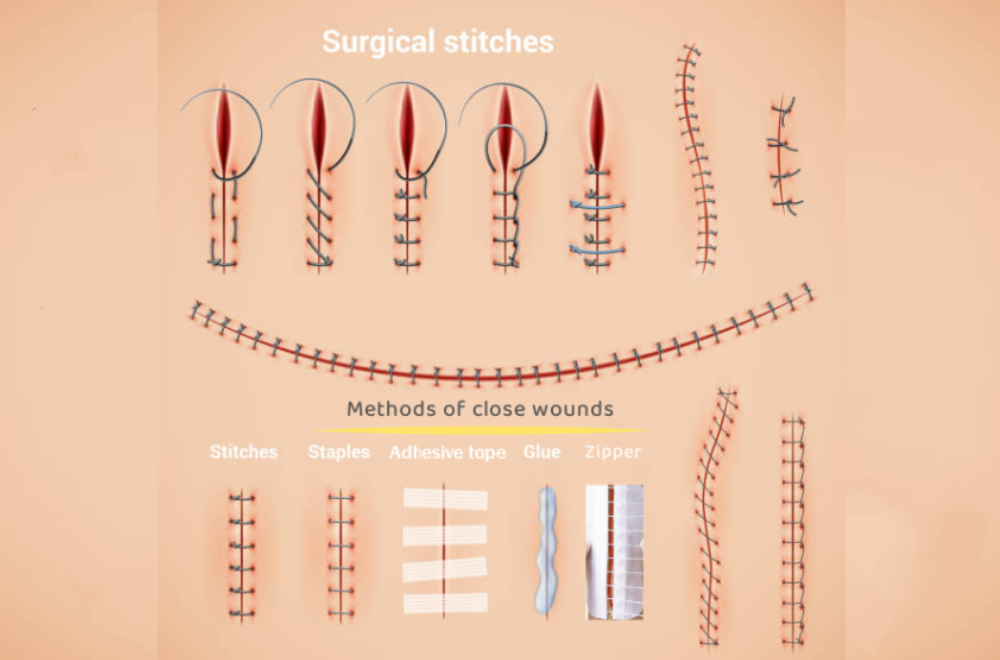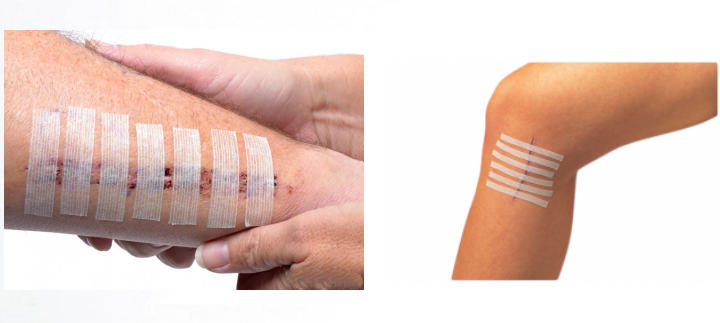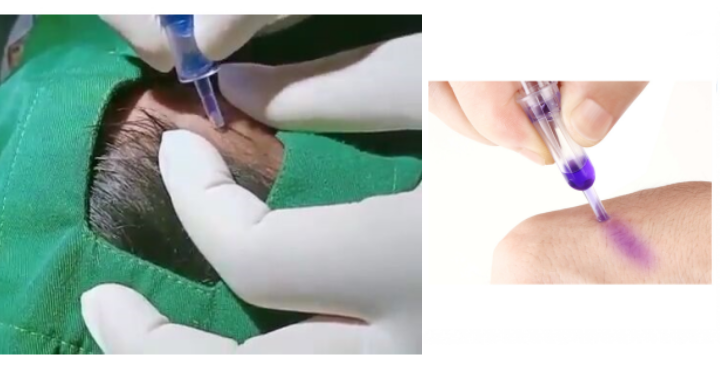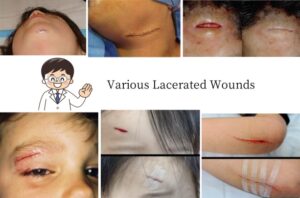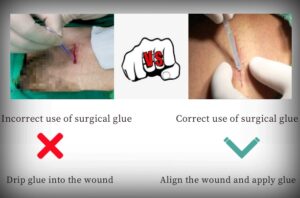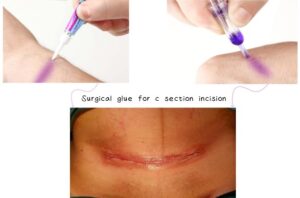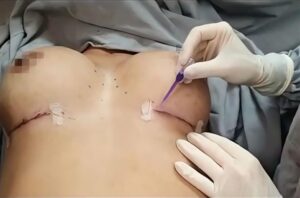In daily life, adults or children may accidentally cut or scrape themselves. For minor cuts, they can be cleaned and covered with a band-aid. However, for more severe wounds, cuts, or lacerations, a doctor may use other methods to close your wound. These may include adhesive tape, stitches, staples, zippers, or liquid skin glue.
The choice of wound closure method will depend on the type of incision, the location of the wound, your age and health status, patient safety and aesthetic requirements, ease of application, the doctor’s preference, prevention of wound complications, and available materials. Why choose surgical glue? See the full guide to its uses and limitations.
Adhesive Tape
Doctors use medical adhesive tape (such as Steri-Strips) to pull together the edges of minor skin wounds.
Advantages of medical adhesive tape
1. Medical adhesive tape costs less than other types of materials used to close wounds.
2. Medical adhesive tape is made from a variety of materials, including porous or non-porous fabric, paper, foam, or plastic, to suit different wounds and locations.
3. Special medical adhesive tapes with waterproof or breathable properties can be used to adhere to surfaces that are either wet or dry.
4. Medical adhesive tape is often made of hypoallergenic materials to prevent skin irritation or damage.
5. Medical adhesive tape has various sizes and shapes to suit different wound sizes and locations.
The disadvantages of medical adhesive tape
Medical adhesive tape can lose its stickiness over time, especially if it gets wet. If it gets loose, the wound can break open.
Stitches (Sutures)
Stitches, also known as sutures, are the most common technique used to close a skin wound. They are usually made of natural or synthetic materials, such as silk, nylon, or polyester, and are used by a surgeon to sew (or stitch) together the two ends of the skin.
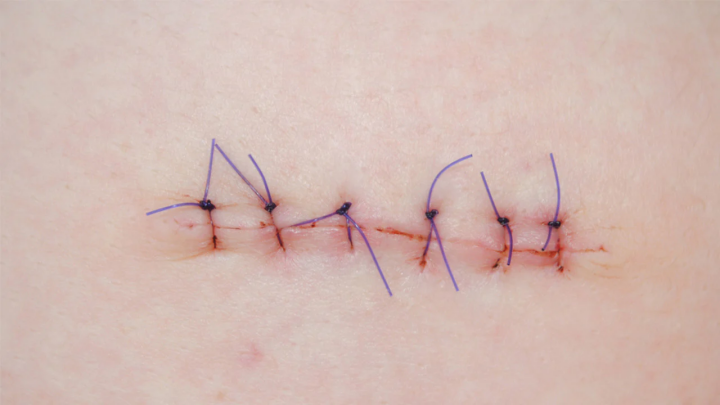
Advantage of Stitches (Sutures)
- There are two kinds of stitches: absorbable and permanent. Absorbable stitches dissolve in the body so they do not have to be removed by a provider.
- Both types of stitches are strong.
- Both are inexpensive.
- Both are useful if there is a cut in an area of the body that moves a lot, such as at a joint or on the hand or foot.
- Absorbable stitches are particularly useful when sewing up cuts that have been made deep inside the body.
Sutures may be permanent or absorbable (they dissolve in the body). Which type your doctor chooses depends on many things, including the type of incision and your risk of infection.
The Disadvantage of Stitches (Sutures)
- Infection: Anytime the skin is broken, there is a risk of infection. While stitches can help to close the wound and reduce the risk of infection, if they are not done properly or if the wound is not kept clean, an infection can occur.
- Scarring: Stitches can sometimes damage healthy tissue, and can leave a scar that may be more or less noticeable depending on various factors such as the location and depth of the wound, the type of sutures used, and how well the wound heals.
- Pain and discomfort: Depending on the location of the wound and the type of stitches used, there may be some pain and discomfort associated with the application and removal of the stitches.
- Allergic reactions: Some people may have an allergic reaction to the materials used in the sutures, which can cause itching, redness, and swelling at the site of the wound.
- Longer healing time: Stitches may take longer to heal than other wound closure methods, such as adhesive strips or staples.
Staples
Staples are a medical tool used to close wounds quickly and easily. The device uses sterile metal staples to hold the edges of a wound together.
They have two types: permanent or absorbable (they dissolve in the body). They are often used in surgical procedures, especially those involving the skin or soft tissue.
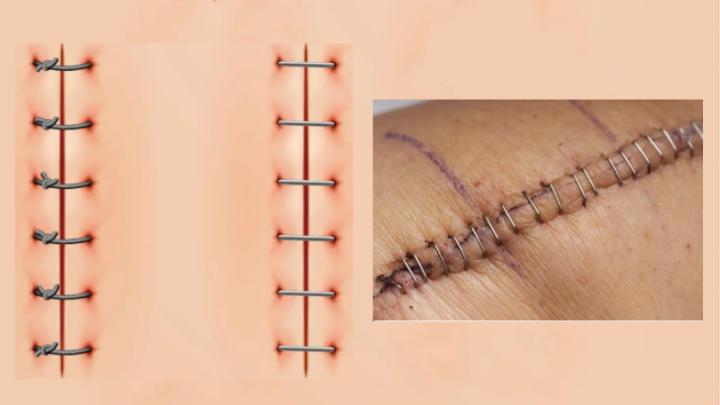
Advantages of Staples
1. Staples are very strong.
2. They can be put in more quickly than stitches. Doctor to quickly close your wound with minimal damage.
3. They’re easier to remove than stitches, and you spend less time under anesthesia.
4. Allowing for faster healing and less scarring than traditional sutures.
5. With absorbable staples, you also have a lower risk of infection.
The Disadvantage of Staplers
- Tissue damage: When the skin is pulled tight during the closure, there is a risk of tissue ischemia (lack of blood flow), which could lead to tissue damage or delayed wound healing.
- Infection risk: If not properly sterilized, skin staplers can increase the risk of infection.
- Removal: Removing staples can be more painful and difficult than removing sutures, as they require a special tool.
- Cosmetic appearance: Staples can leave more visible scarring than other wound closure methods, particularly in areas like the face.
- Cost: Skin staplers can be more expensive than traditional sutures.
Zipper
The zipper consists of two parallel rows of interlocking plastic hooks and Velcro-like loops that can be pulled together to close a wound. It is an alternative to conventional sutures. It’s often used for wounds that need to be monitored by your doctor on a regular basis.
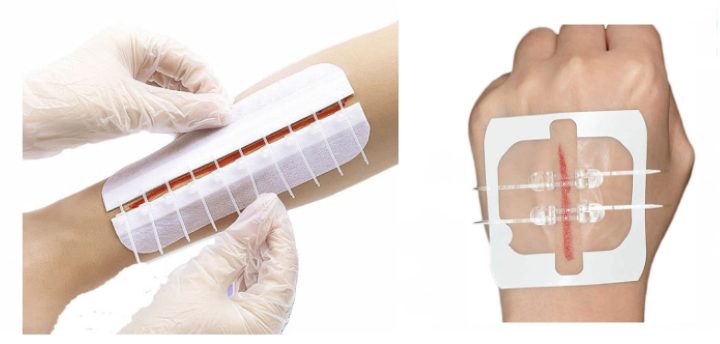
Advantages of Zipper
- Faster healing: A zipper for wounds can provide a faster and more efficient method of closure than traditional methods like sutures or staples.
- Less scarring: Because the zipper lays flat against the skin, it may cause less scarring than other types of wound closures.
- Versatile: Zipper closures can be used in a wide variety of situations, including surgical incisions, lacerations, and deep wounds.
- Easy to apply: Zipper closures are easy to apply and require minimal training, making them a good option for emergency or field settings.
- Painless to remove: Studies show it’s painless to remove, so it could be a good option for kids.
- Reusable: In some cases, a zipper for wounds can be reused, which can help reduce the overall cost of wound closure.
The Disadvantages of Zipper
- Increased Risk of Infection: Zipper closures may increase the risk of infection as the teeth of the zipper can harbor bacteria, making it difficult to clean and disinfect.
- Limited research: Because zipper closures are still a relatively new technology, there is limited research on their effectiveness and long-term outcomes.
- Tissue Necrosis: The pressure exerted by the zipper on the skin and underlying tissues can result in tissue death or necrosis, leading to delayed healing and scarring.
- Pain and Discomfort: Zipper closures can cause pain and discomfort, especially if they are too tight or rub against the wound site.
- Limited Flexibility: Zippers can restrict movement and limit the flexibility of the affected body part, making it difficult for the patient to perform daily activities.
- Allergic Reactions: Some patients may develop an allergic reaction to the materials used in the zipper, such as metal or synthetic fibers.
- Difficult to Remove: Removing a zipper closure can be difficult and painful, especially if it has become embedded in the skin or wound tissue.
Liquid Skin Glue
Liquid skin glue is a type of medical super glue that is used to close minor cuts, wounds, and incisions. It is used as an alternative to traditional sutures or staples and is typically made from a cyanoacrylate compound (N-butyl cyanoacrylate or 2-octyl cyanoacrylate ), which is a type of fast-drying and strong adhesive. When applied to the skin, the glue quickly bonds the edges of the wound together, creating a strong, waterproof seal that can help prevent infection and promote healing. Differences between N-butyl cyanoacrylate and 2-octyl cyanoacrylate.
Liquid skin glue is commonly used in hospitals or clinics, ect medical contexts, and is also popular among athletes, as it allows them to quickly seal minor cuts or abrasions and get back to their activities without the need for bulky bandages or dressings.
Advantages of Liquid Skin Glue
- Quick and virtually painless to use.
- Sedation isn’t needed when liquid skin glue is used. This can be especially beneficial when treating young children.
- Liquid skin glue takes less time than stitches.
- There is nothing to remove and after 7-10 days the adhesive eventually breaks down and is absorbed (internally) or peels and falls off (externally).
- There is a lower risk of infection.
- Adhesives have a lower risk of scarring.
The Disadvantages of Liquid Skin Glue
- Not suitable for all wound types: Especially those that are deep, jagged, gaping, infected, or inflamed.
- Allergic reactions: Some individuals may experience an allergic reaction to the chemicals in the skin glue, leading to inflammation, itching, and pain.Allergic symptoms and treatment methods of liquid skin adhesive.
- Risk of infection: Make sure to clean the wound properly before applying liquid skin glue to prevent infection.
Liquid Skin Glue is best used for cuts or wounds that meet the following criteria:
- small (less than 4 cm)
- clean (not contaminated with dirt/debris or have a risk for infection)
- linear/straight (no jagged edges, multiple edges, or complex cuts)
- low tension wounds (a wound over a joint or a cut on the forehead that goes up and down under high tension.)
When considering minimally invasive options, our liquid wound closure solution offers scarless closure techniques.
Skin adhesive is often used to close wounds on:
- the face or head
- some parts of the arms and legs
- the trunk of the body (torso)
Skin adhesive isn’t suitable for wounds over joints, like your knees, groin, or hands.
Skin adhesive glue takes only a few minutes to set. The glue usually forms a scab that peels or falls off in 5 to 10 days. In some countries, surgeons often use this skin adhesive glue to seal incisions from circumcision surgery in children. Application of Skin Adhesive Glue in Circumcision of Children.
Overall, each of the above methods for closing wounds has its own advantages and disadvantages. It’s important to discuss with your healthcare provider which method of wound closure is best suited for your individual situation and needs.

